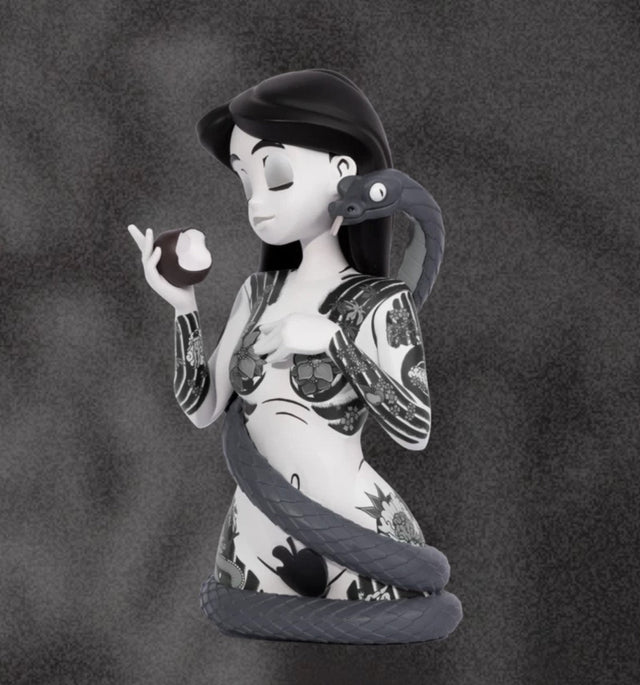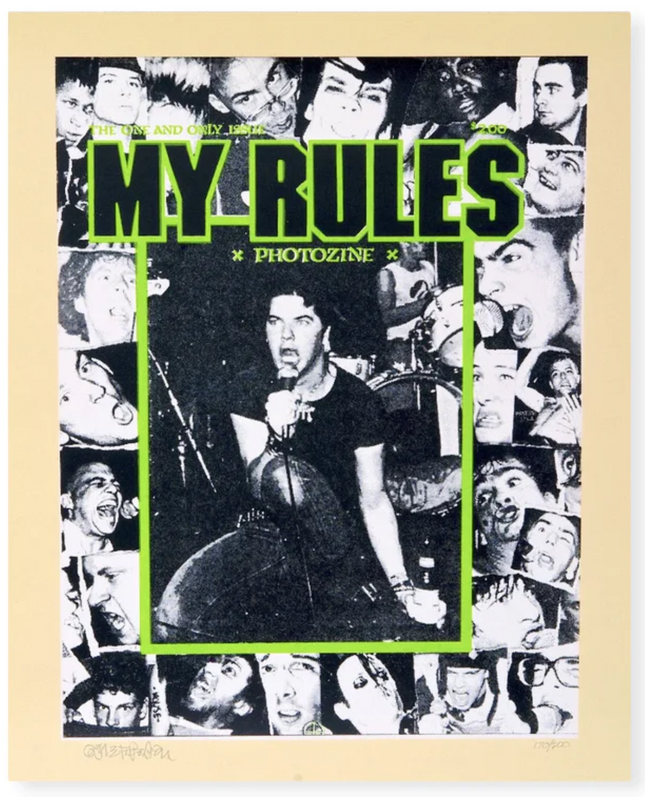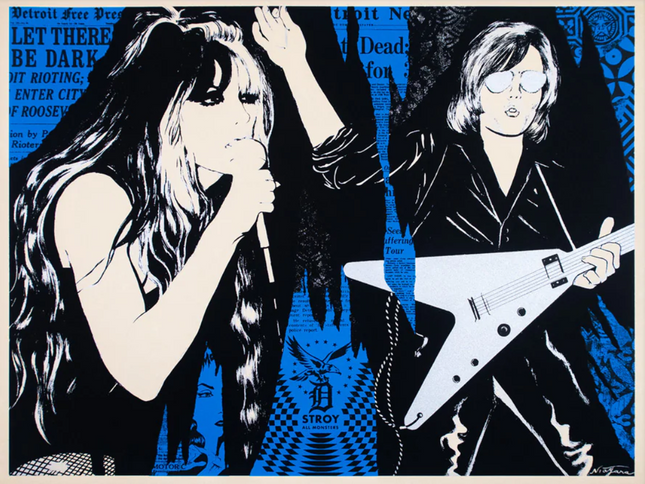Let There Be Dark Blue PP Printers Proof Silkscreen Print by Shepard Fairey- OBEY x Niagara Hand-Pulled 3-Color on 320gsm Natural Coventry Rag Vellum Fine Art Paper Limited Edition Artwork Obey Pop Culture Artist.
PP Printer Proof 2019 Signed & Marked PP Limited Edition Artwork Size 24x18 Silkscreen Print
"I chose an image of Ron and Niagara where I think they both look amazing, but there was a nice balance between in-your-face aggression with Ron's pose making eye contact, holding his fist up, and Niagara's seemingly demure embrace of Ron, but anyone who knows Niagara understands that though she may look sedate, she's pulling the strings. I added a switchblade that she is caressing with her finger, as a way to amplify her femme fatale chic, and because I thought it lent itself to my original idea of a title 'Bonnie & Clyde Were Lightweights'" -Shepard Fairey- OBEY
Shepard Fairey's 'Let There Be Dark Blue': A Portrait of Rebellion in Print
Shepard Fairey, the artist behind the OBEY brand, is a force to be reckoned with in street pop art and graffiti artwork. His 'Let There Be Dark Blue PP Printer's Proof Silkscreen Print,' created in collaboration with artist Niagara, is a powerful embodiment of his iconic style and the subversive edge of street culture. The 2019 limited edition hand-pulled print, signed and marked as a Printer's Proof, is a collector's piece, reflecting a synthesis of Fairey's design sensibility and the punk rock ethos encapsulated by the figures of Ron and Niagara. The artwork, 24x18 inches and printed on 320gsm Natural Coventry Rag Vellum fine art paper, features Fairey's signature three-color silkscreen process, yielding a print with crisp lines and bold contrast. The image exudes raw energy, with Ron's assertive eye contact and raised fist paired with Niagara's subtle yet commanding presence. Fairey enhances this dynamic by cleverly adding a switchblade, augmenting Niagara's femme fatale allure and highlighting her understated control within the composition.
Interpreting Fairey's Vision and Artistic Narrative
In 'Let There Be Dark Blue,' Fairey draws on the powerful imagery of cultural rebellion and the dichotomy of strength and subtlety. His portrayal of the two figures is steeped in a narrative that transcends the print, suggesting a story of defiance, control, and the complexities of interpersonal dynamics. The title, 'Let There Be Dark Blue,' hints at a theme of emergence, breaking from the conventional into the shadows where the counterculture thrives. As recounted by Fairey, the original idea for the title, 'Bonnie & Clyde Were Lightweights,' sets the tone for an interpretation of the print as a modern-day outlaw saga. This narrative is further emphasized by the backdrop of newspaper headlines and text, suggesting turmoil and the clamor of society against which the central figures stand in stark relief. Through this print, Fairey not only captures the aesthetic of the punk rock scene but also comments on the enduring spirit of rebellion it represents.
The Significance of 'Let There Be Dark Blue' in Street Art
The cultural significance of 'Let There Be Dark Blue' within the street art community is multi-layered. The print is a visual feast and a thought-provoking piece that invites reflection on the role of art as a commentary on society. Shepard Fairey's work is often associated with social and political activism, and this print fits within his broader oeuvre as a medium for messaging and reflection. Furthermore, the piece celebrates the collaborative spirit inherent in street art culture. The partnership between Fairey and Niagara exemplifies the communal aspect of the genre, where artists come together to create works that are greater than the sum of their parts. The limited edition nature of the print and its status as a Printer's Proof enhances its value and desirability, capturing a moment in time when the energy of street culture is distilled into a single, tangible work of art. In essence, 'Let There Be Dark Blue' by Shepard Fairey is a testament to the vibrancy and potency of street pop art and graffiti artwork. It encapsulates the defiance, the style, and the narrative depth that defines the street art movement, inviting audiences to engage with a piece of art that is as thought-provoking as it is visually striking. Through this print, Fairey continues to push the boundaries of what street art can convey, solidifying his role as a pivotal figure in the contemporary art world.
Read more less



